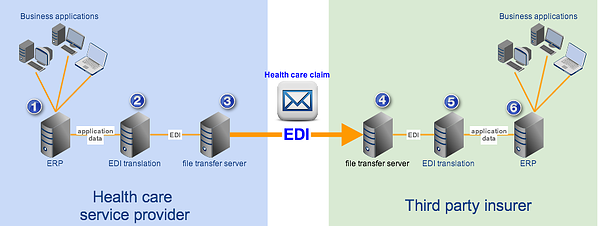HIPAA EDI Document Standard. Secure EDI Healthcare Solutions.
 Securing Hipaa Edi Transactions With As2 Jscape
Securing Hipaa Edi Transactions With As2 Jscape
The Health Insurance Portability and Accountability Act was enacted by the US congress in 1996.
Edi hipaa compliance. The HIPAA EDI Rule defines 3 groups referred to as Covered Entities that must comply with the HIPAA EDI Rule. Instead EDI translationcommunication software is marketed as HIPAA EDI Ready if it has the capabilities. The Covered Entities are Health Plans Health Care Clearinghouses and Health Care Providers.
Simplify your business processes and EDI healthcare transactions with enhanced visibility flexibility and data management with full compliance. EDI 837 transaction set is used by a health care provider to submit an insurance payer healthcare medical claims billing information. The Covered Entities are Health Plans Health Care Clearinghouses and Health Care Providers.
While Highmark EDI Operations accepts HIPAA-compliant transactions from any covered entity HIPAA security requirements dictate that proper procedure is established to. Tier 1 which refers to unknowing violations. When a medical document is converted to a HIPAA EDI transaction set it acquires a standard code and name.
EDI Solutions for Healthcare Industries HQX is the worlds leading enterprise EDI software solution. Under the HIPAA electronic data interchange EDI rule electronic communication exchanges are exchanges of data between two entities to carry out financial or administrative activities related to healthcare. If an intermediary such as a clearinghouse is used to help reformat claims to conform to the HIPAA standard much of the compliance with HIPAAs EDI rules will be met by that entity.
X12 270 and 271 Healthcare Eligibility. X12 837 Healthcare Medical Claims. Common examples of health plans include.
There are four tiers of non-compliance. We are a Health Plan when conducting business activities for certain of its products called covered products. The most commonly used EDI HIPAA transaction in medical practice are.
The Covered Entities are Health Plans Health Care Clearinghouses and Health Care Providers. HIPAA IT infrastructure must meet evolving standards. HIPAA and EDI The Health Insurance Portability and Accountability Act HIPAA was enacted in 1996 to create a variety of regulations in the healthcare industry many of which are related to insurance eligibility and protection for Americans when switching insurance carriers after changing jobs.
With healthcare IT growing the need for federally compliant infrastructure to process and store the electronic protected health information ePHI that is protected by the Health insurance Portability and Accountability Act HIPAA is on the rise as well. HIPAA introduced the X12 270271 pair of EDI transaction sets to automate this important exchange of information so now more and more providers and payers are starting to use it especially since the Affordable Care Act ACA. We are a Health Plan when conducting business activities for certain of its products called covered products.
The HIPAA EDI rule is discussed in greater detail below. To add more complexity this law mandates payers to implement a real-time response solution for common provider request. A key component of HIPAA is the establishment of national standards for electronic health care transactions and national identifiers for providers health insurance plans and employers.
The rule defines the types of EDI transactions subject to HIPAA and specifies the exact format for each transaction record. A common example of such an exchange is a providers sending a claim to say a health plan to request payment for medical services. Any entities covered by the HIPAA EDI Rule should be aware that penalties for non-compliance are high.
It reduces the exposure of private patient records to unauthorized entities while increasing the speed accuracy and efficiency of record-keeping. The HIPAA EDI rule is a set of data transmission specifications. Although organizations rely on HIPAA EDI compatible software to comply with HIPAA EDI standards actual endorsed HIPAA EDI Compliant software does not exist.
Ready to get started with EDI. These specifications govern how data is electronically transferred from one computer to another. I A Health Plan is an individual or group plan that provides or pays the cost of medical care.
The Department of Health and Human Services Office of Civil Rights HHS is responsible for ensuring compliance with the HIPAA EDI Rule. EDI Transaction Standards EDI transaction standards. Text in Blue shows the receiver of the transaction.
Healthcare Electronic Data Interchange enhances compliance with HIPAA guidelines by streamlining the handling of medical records and other sensitive documents. Although the process of initially submitting the claim to the intermediary and the analysis of payments remain under the control of the provider the mechanical process of reformatting the. The regulation defines three groups referred to as Covered Entities that must comply with the HIPAA EDI Rule.
The HIPAA EDI Rule defines 3 groups referred to as Covered Entities that must comply with the HIPAA EDI Rule. The standards are meant to improve the efficiency and effectiveness of the North American health care system by encouraging the widespread use of EDI. Text in Orange shows the sender of the transaction.
Some transactions do not define a specific sender andor receiver.
